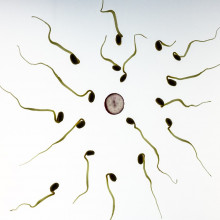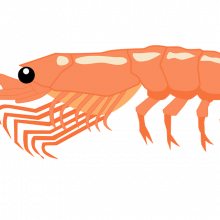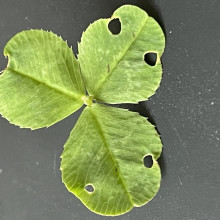Are we any closer to a contraceptive for men, will a 4 day work week pay for itself, and how cretaceous caterpillars helped scientists work out when plants first opened and closed their leaves...
In this episode

00:52 - Male contraceptive puts sperm to sleep
Male contraceptive puts sperm to sleep
Melanie Balbach, Weill Cornell Medical College
In the 1950s the European chemist Carl Djerassi changed the course of history, many argue, when he found a way to produce human sex hormones, including oestrogens and progesterones. These were subsequently turned into contraceptives, earning Djerassi the accolade of being “the father of the pill”, that’s since been taken by millions of women. And there contraception has largely remained ever since: as chiefly a female domain. Efforts have been made to generate male contraceptives, but this has proved to be a very hard nut to crack. Until now, perhaps. Because Cornell scientist Melanie Balbach and her colleagues have developed a drug that, taken half an hour beforehand, can temporarily immobilise sperm for at least a few hours, preventing them from fertilising eggs. Mice given the agent produced no pregnancies, but quickly recovered their fertility as soon as it was stopped.
Melanie - The idea is that the men take our pill 30 minutes before they have intercourse and that protective window will last about 24 hours and after that they get their fertility back.
Chris - So it's a reversible temporary interruption infertility.
Melanie - Exactly. So how it works is we're blocking the "on" switch in sperm. So what happens is, when the sperm are produced, they are stored in a tissue where they're sitting in a sleeping state and then when they are ejaculated they have to become motile and our target is responsible for that onset of motility for the sperm. So what we do is we inhibit that target so we stop it from being activated so the sperm remain imotile and they can't swim to the egg site and fertilise. What we're using to inhibit it is a chemical.
Chris - And that's what? A chemical that you found?
Melanie - Exactly. Our lab has been studying that “on” switch for 20 years. So we were actually looking for chemicals that would block it. So what we started with is something called a high throughput screen. What you essentially do is you have your target, your protein of interest, and there's actually a library of chemicals out there that you can look into and find the ones that are blocking your protein. And once we found such a chemical, we were further improving it to have the properties we need for a male contraceptive.
Chris - Is it selective? In other words, does it just hit sperm or does it hit other tissues? Because obviously one thing that has thwarted other efforts in this direction towards a male contraceptive have been off target side effects.
Melanie - That "on" switch and sperm actually also plays a role in other tissues. So our inhibitor, our chemical, can affect the protein there theoretically as well. But what is different in all these other tissues and organs, all the other organs have a sister protein that has the same function. So in all the other organs, even if our protein is blocked, those other tissues will still be okay because they still have that sister enzyme or that sister protein working. Whereas in the sperm exclusively our protein is responsible. So that's why we have such a stronger effect in the sperm than anywhere else.
Chris - How did you test that? Because obviously this has not gone into humans yet. How have you figured out that this is what it does?
Melanie - We did studies in mice and the first thing I did is I looked at their sperm and what I found is that the sperm of those male mice were not swimming. Their motility was inhibited after 15 minutes and then that lasted about three hours and then it slowly came back and by 24 hours their motility was completely back to normal. So then the second thing I did was mating experiments. So I gave that inhibitor to the male mice and then I paired them with females and then I checked if those females were pregnant. And again with that first window of three hours, we did not get any pregnancies with the females. And then when I kept the males and the females together for longer, I slowly got pregnancies and then, by 24 hours, it was a normal pregnancy rate again in both females.
Chris - It's amazing. It's a very, very powerful effect isn't it? If you've got no pregnancies at all, especially with mice because they're pretty fertile. What about will it work in humans? That's obviously the critical question.
Melanie - So we are very optimistic that it will because of two things: one thing is that that protein we have been talking about actually has the same function in human sperm as in mouse sperm. And the second thing is that I can take sperm from human donors and I can add our chemical to the sperm. And what I see there is that the human sperm stops swimming there.

06:22 - Is the 4 day working week a success?
Is the 4 day working week a success?
Brendan Burchall, University of Cambridge
As previously promised, it’s time to circle back and discuss the findings of a study conducted by the University of Cambridge’s Brendan Burchall and colleagues looking into a 4 day working week. We spoke to Brendan right at the start of the trials which saw 61 companies take part in adjusting their schedules to provide participating employees with a big incentive: improve your productivity by 20% from Monday to Thursday and you can have Fridays off. The initiative was organised by campaign group 4 Day Working Week Global, which gave academics from Cambridge and Boston College in the US “under the bonnet” access to participating organisations’ finances, as well as regular updates from managers and employees. James Tytko heard about the results…
Brendan - So at the company level, we could see very clearly very significant reduction in absenteeism rates. Turnover went down, people didn't want to leave these companies. Where there were changes in the performance, their output, however they measured it. And they all measured it in different ways. But if anything, the performance tended to go up, not down, despite the cutting hours. When we looked at things like the burnout, the stress levels, the sleep quality, all those sorts of psychological and social indicators for the employees, again, across the board we saw improvements, really quite dramatic improvements. We asked people at the end of the trial whether they're happy they'd want to continue, the vast majority of employees were very happy to continue with working in this new way. And over 90% of the companies were definitely going to carry on with it. Others were having a pause and maybe thinking of redesigning it, but very unusual for any of the companies to think that they're going to go back to a five day week.
James - So what do you put that increase in productivity in fewer hours down to?
Brendan - I think overwhelmingly the biggest thing to happen was there was such a big reward for both employers and employees. A 50% increase in your weekends beyond their wildest dreams. So they were motivated to make these things work and they could then start to really radically rethink the way they were doing things, the way they were having meetings, the way that the objects or data flowed through the organization, the way that they communicated with each other, the way that they maybe were more flexible when they spotted bottlenecks in the way that things got done.
James - And I suppose, what do you say to people who might think that companies might use the initiatives that help their workforce produce the same level out of output in four days? Then they can go back to five days. And while the four day work week has of course helped their company, it's not in the way that you necessarily envisaged.
Brendan - It would be so unthinkable for companies to do that. Everyone had the same goals. If you backtracked, then I think you would lose that trust and that goodwill. And you really did have an unscrupulous boss who then thought, right, we're going to, now that means we come sack a fifth of the workforce and go back to five days a week that he would have a, or she would have a nasty surprise.
James - And I'm sure you're probably familiar with the point that this might not work in all industries. Ones which need a certain number of staff on site at all times, or where output is heavily linked with hours worked.
Brendan - Very often I start conversations where someone says to me, 'but of course it couldn't work in a ...'. And that could be a hospital or school. And actually when we start talking it through, I think there are, would be massive, similar efficiencies to be made in many of the industries. There's not many industries where the employees have to be there for exactly the same number of hours that the customers are getting a service. You know,
James - But it's not zero.
Brendan - Yep. I'm sure there would be organizations that would struggle, but I think if I was to predict what's going to happen over the next three or four years, organizations that want to attract the best talent are going to have to advertise four day week jobs. And then other companies are going to have to fall in line. When people realize, you know, just how nice it is to have Friday off as part of your weekends. Then yeah, it's just those companies, even if they're dragged kicking and screaming, they won't have any choice but to also be operating four days a week.
James - I suppose one other thing I might like to ask is whether what you've done here is kind of shine a light on the problem being that the uncomfortable <laugh> truth that people don't enjoy working that much and that this trial has provided people with the incentive of getting as much done in four days to clean up their act. And when the threat of going back to five days is removed, you might see a slide in productivity again.
Brendan - I think there's two points there. One is what's going to happen in the longer term. This is all new and it's interesting and people are very keen to adopt these new ways of working, but the novelty will wear off. And we don't know. We'll have to keep going with it. But also there are people who are interested in working time reduction because they're what you could call 'anti work'. They think that work is a way that people get exploited and we should try and liberate ourselves from it. I don't believe that. I think people are definitely happier when paid work is a part of their life. I know from my own data that people are unemployed or excluded from the labour market for other reasons, maybe because they're caring for children or for whatever reason. Their mental health isn't as good. I think work is good for you. But five days of work and two days off is too much and four days on and three days off is much healthier time for other interests, sports, hobbies, community work, whatever is a much healthier balance.

12:14 - Shiny shrimps with invisible eyes
Shiny shrimps with invisible eyes
Ben Palmer, Ben-Gurion University of the Negev
Vulnerable juvenile marine creatures have an incredible strategy to escape being eaten before they grow sufficiently large to defend themselves: they resort to invisibility, by making themselves transparent. But they cannot work for the eye, because when you collect light in order to see it, you leave a dark spot, which predators can see. To get around the problem, some shrimp larvae cram their retinas with assemblages of tiny orbs, or nanospheres, which can bend light from the surroundings out into the direction of their gaze, making their eyes disappear. The optical properties of these nanospheres are tuned to the environments in which the animals live, as Will Tingle heard from Ben-Gurion University of the Negev’s Ben Palmer...
Ben - Many oceanic animals start their life as plankton. So these are small animals floating around in the open ocean, kind of at the whim of currents and that sort of thing. And they float around and they're largely defenceless organisms. But one of the strategies they've developed to avoid being eaten by predators is to become transparent. So there's almost no pigment in them at all. And they sort of appear almost glass like. But one of the places where you can't do away with pigment is in your eyes. So if you want to see, you have to absorb photons of light, which need to be captured by pigments. And if it wasn't for this reflector, then the animals would appear as two black dots on a transparent background. So the idea of this reflector is that it's a camouflage device which covers those absorbing pigments, those dark pigments in the eye. And the colour of this reflector is matched to the watercolour of the habitat that the organisms live in. So they are matched with the background and essentially appear invisible to predators.
Will - Is this a conscious choice or is this just how refraction works?
Ben - So this is definitely not a conscious choice. These organisms have this feature genetically hardwired into them. So what we found is that in different species of crustaceans, which occupy slightly different habitats in the water, then they have different eye colours which are matched to those water colours that they live in. So from deep blue all the way through to kind of yellow green. And the way that this reflector is tuned to match those colours is the size of those nanospheres. So in each species you find a different size of nanoparticle, which is optimised to camouflage it in the water that it lives in.
Will - Does this change if the individual is moved from one environment to the other?
Ben - We did find in one particular species that this organism did change its eye colour in the dark and the light. So this was found serendipitously by the student working on this project. She found, I think one morning when she came in, that the shrimp that had been in the dark had changed their eye colour from yellow to green. And this was a reversible change. So when you switch the light back on, they're able to change their eye colour, they maintain the size of the spheres. This seems to be something that's hardwired into each species. What they do is subtly change the arrangement of the spheres, and this changes the optical properties of the reflector.
Will - Do these crystals stick around when they become adults, and does that function change as they get older?
Ben - So this is a really interesting question actually. The decapod crustacean, so we're talking about shrimp, prawns, lobsters and so forth, they have a very interesting and complicated life cycle. So they begin as a kind of larval animal floating around the open ocean. And then they undergo this very dramatic metamorphosis event, which is akin to a caterpillar changing into a butterfly. And they completely change their behaviour, their habitat and anatomy and visual system. It's all altered. And actually, we first found this crystalline material in the adult crustaceans a few years ago. Adult crustaceans have a very amazing complicated eye called a reflective compound eye which, unlike our eyes, uses reflectors rather than lenses to do the optics and that was made of crystals that we discovered a few years ago. The reflector in the adult eyes is actually placed behind the retina. And the idea there is that light that gets transmitted through the retina gets a second chance to be absorbed. So it bounces back off this reflector, which is made of crystals, back to the retina to increase the photon capture of the eye.
Will - These crystals are organic. And do you think that the discovery of these crystals, or rather the discovery of how useful they are in their manipulation, might have an impact on our own material construction?
Ben - There is a growing field of bio-inspired materials and particularly bio-inspired optical materials. And there's growing interest in trying to find highly reflective materials which are organic as replacements for inorganic nanoparticles, for example, which are used currently in things like pigments, paints, cosmetics. So there is actually a growing interest and a growing sort of field in this area, trying to explore how we can take this information and translate it into real world applications of these sorts.
Will - But not quite an invisibility cloak just yet.
Ben - I think definitely we're some way off that. And I think there's many things we still have got to learn. So we're really trying to 1. Enjoy the pleasure of understanding these systems from a fundamental point of view, but also trying to learn what it is they're doing and how we can translate that into real world applications.

17:55 - Earliest bows and arrows in Europe
Earliest bows and arrows in Europe
Emma Pomeroy, University of Cambridge
The bow and arrow is arguably one of the most important tools our ancestors invented. But when did they do that, where, and how did this technology spread? And what role, if any, did it play in helping anatomically modern humans - i.e. us - to migrate out of Africa and across the rest of the world? And did we share these tools with our Neanderthal relatives who coexisted alongside us for much of our evolutionary history. Or, more macabre, did us having these weapons contribute to the eventual disappearance of Neanderthals 40,000 years ago? Some of these questions have been answered this week in a cave in France, where Laure Metz uncovered tiny flint points that, her experiments show, appear to have been used as arrowheads. She even fired replicas into dead goats to prove they really work. Emma Pomeroy is an archaeologist who studies this period in our history at the University of Cambridge. I asked her to take a look at the findings for me…
Emma - This study is reporting what is probably the earliest evidence for bow and arrow use in Europe. It's from a site called Grotte Mandrin which is in the Rhone Valley in France. And these are stone tools from a particular layer - layer E - that dates to about 54,000 years ago. It includes these really tiny points that are less than one centimetre across. So what they've done is some really detailed analysis, including microscopic work to see what they were used for and some experimental work to compare how these kinds of points would break when they're fired into something. And basically they've concluded and shown really interesting evidence that these tiny points were likely mounted on the end of a shaft and used as a projectile. And it's significant because we know from recent populations who use bows and arrows, when you put a tip on the end of a shaft like this, those tips aren't effective if the shaft is much wider than the tip itself. So these must have been on really narrow shafts with a narrow projectile like that. They're not effective if you throw them. So that indicates that they must have been used with a bow and arrow. So this pushes back the date for this mechanically assisted technology in Europe by about 10,000 years. And also the presence of modern humans, interestingly, by about 10,000 years.
Chris - And who would've been wielding these weapons?
Emma - So that's a really good question, and it's one that's sometimes hard to be a hundred percent sure of because if we find particular tools, it's really hard to know which group of human ancestors might have produced and used them. And we know, for example, in this area at this time, there are Neanderthals and our own species, modern humans around. The assumption has long been that this kind of mechanically assisted projectile technology is associated with our species, with modern humans. And interestingly, at this site in the same layer, layer E, they actually found a tooth which belongs to a modern human rather than a Neanderthal. And in the layers above and below, they found Neanderthal teeth in those layers. So of course, the association between the tools and the teeth isn't necessarily saying that has to be that species that made it because their teeth are in the same layer, but it is quite suggestive that those are the kinds of humans that are around at that time. And so they're producing the tools and similarly, for example, at a site in Italy where we have some early projectile evidence as well, we have that evidence in association with modern human remains too.
Chris - Not long after this time Neanderthals disappear from the timeline. So do you think the two are connected?
Emma - Oh, it's possible. And that's an interesting argument that is sort of of suggested in this paper. So Neanderthals really go extinct in Eurasia about 40,000 years ago. So that's a good 14,000 years more recently than these particular artifacts. But one suggestion they're making is that these are sort of early forays by modern humans into Europe with this more complex technology and that that might have played a role in giving them perhaps a competitive edge over Neanderthals.
Chris - What do you think might have provoked anatomically modern humans who engineered this technology to invent it in the first place? And why them not the Neanderthals if they were overlapping in similar environments therefore presumably getting the same advantage from these sorts of technologies? Why did one not get it from the other or both invent it independently if it was so advantageous?
Emma - That's a really good question, and that's something that academics have debated about for a long time, and there might be various factors involved. So one idea is that anatomically modern humans, our species, were capable of more innovative behaviour and coming up with new ideas and new technology more frequently than the Neanderthals. There might be an element of chance in it as well. So even amongst different modern human populations, we know that not all of them had the bow and arrow and not all of them independently invented it. In those that didn't already have it, you could also ask, and this is suggested in the paper, if these modern humans are turning up and they've got this really advantageous technology, why don't the Neanderthals here in that region think, "This looks good. This would be good for us. We'll copy that and do the same." Or perhaps in this case as well we know Neanderthals and modern humans are using the same site, but the extent to which they actually encountered each other and had the opportunity to see what each other were doing and perhaps stop that technology we don't know.

24:05 - Fossil bug bites reveal plant leaf movements
Fossil bug bites reveal plant leaf movements
Steve Mcloughlin, Swedish History Museum
Many plants open and close their leaves and petals on a daily basis, but how and when did this evolve? Incredibly, insect bite marks in fossilised leaf remains have helped to shed some light on this. Scientists have stumbled on leaf fossils with holes in them where presumably a big hungry cretaceous caterpillar has made a meal of them; but these holes are symmetrical about the leaf’s midline. And the scientists who’ve found them think this is because when the animal bit into it, the leaf was closed; when it opened again, the hole was in both surfaces; it’s a bit like when children make symmetrical paper doily cutouts by folding a piece of paper in half and trimming the folded surface. Steve Mcloughlin, from the Swedish History Museum in Stockholm, told James Tytko what they think they’ve found…
Steve - So I had a Chinese colleague, Zhuo Feng, but he noticed back in 2013 that some of these sleeping plants have a particular symmetrical line of damage down each side of the leaf. When they fold up their leaves at night, the insects bite through one side of the leaf and come out the other side. So they have symmetrical rows of damage on the leaf. And then he started to look out for this damage in the fossil record. And then in 2016, he found a fossil leaf from an extinct 255 million year old plant called a Gigantopterid from China. And it had exactly the same type of damage down each side of the midline of the leaf. Now one specimen is not always convincing to the reviewers, so he kept on looking and last year he found another specimen with exactly the same type of symmetrical damage. We think that these are mature leaves and that it represents the first real evidence, in the fossil record, of leaves that folded up in the past into this very distinctive sleeping behavior.
James - Could you go through again, just what the giveaway clues were in those particular samples that this leaf folding behaviour was occurring all those millions of years ago?
Steve - It's the symmetrical nature of the holes. So we have these broad leaves. They look a little bit like an oak leaf. The fossils that we found have these regular holes sort of parallel to the mid vein. And it seems unlikely that two insects created exactly the same chain of holes down either side of the leaf. So the more sensible explanation is that the leaf folded up along the midline and that an insect chewed through the leaf.
James - So that insect got two for the price of one when it took a bite in that leaf, it got through to two layers. Why is it that these leaves actually do this in the first place? What does the plant gain from folding up at night in this daily cycle?
Steve - Well that's a very good question, and it's intrigued botanists for a very long time. In fact, Charles Darwin and his son Francis, wrote a book covering this topic back in 1880. It was called the Power of Movement in Plants. And it sold out very quickly because people were really intrigued by these sorts of movements. It occurs a lot in tropical plants, but not all tropical plants. And it also occurs in temperate plants. So if you go into a local temperate woodland or meadow, you'll find things like clover and wood sorrels that also fold up at night. It clearly must have some benefits to the plants because many plants do it. People have suggested it's temperature regulation. If you close the leaves up, you are less likely to be frosted. But that seems to be very minimal benefit for temperature. It might only be a fraction of a degree. Some have suggested it's improved shedding of water, but there are other adaptations that leaves do that would be much better for shedding water. And then there are the more trophic or multi trophic suggestions where, if you rotate your leaves upright or fold your leaves up, it makes the surface less accessible to insects that will chew on the leaf. Or it might also be that the herbivorous insects that land on a vertical leaf become easier to see for carnivorous insects or other animals that are patrolling the night forests. So we really don't know. It still remains a field of open research, but there are many potential reasons that plants might do it.
James - Fascinating. So this is your sort of mission to get to the bottom of this mystery. Are you waiting essentially for some new fossils to blow the case wide open?
Steve - Yeah. Well, as we were doing a literature survey for this project, we came across some illustrations of fossils that might also have had this behavior. At least they have, these are mostly legume fossils, and they have what's called a pulvinus, a thickening at the base of the leaf. And it's in this thickening that, in modern plants, the calcium and potassium ions activated and helped change the turgor that moves the leaf. So I think there is probably more evidence out there for this behavior, but people just haven't looked for it.










Comments
Add a comment